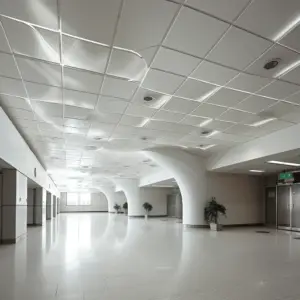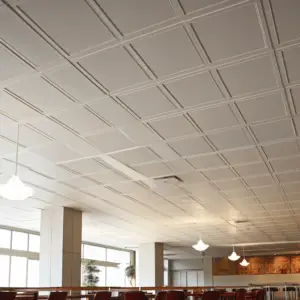Thanks to the rise of green building materials, many people are now turning to alternative materials for their interior projects. One such material is cellulose ceiling tiles. Although they may look like traditional asbestos ceiling tiles on the surface, there are some important differences between the two that you should consider before making your decision.
Table of Contents
Cellulose Ceiling Tiles

Cellulose ceiling tiles are made from a mixture of recycled cardboard, wood fiber, chalk, and other minerals. They are fire-resistant and have excellent acoustic properties.
The main advantage of cellulose ceiling tiles is that they are water-resistant, which makes them ideal for areas that get a lot of moisture. They also offer good insulation, so they can help keep your home warm during winter and cool during summer.
Asbestos Ceiling Tiles
Asbestos ceiling tiles were once very popular because they were cheap and easy to install; however, there are many disadvantages associated with them as well.
It contains tiny fibers that can become airborne if they break or wear out prematurely; if inhaled by someone who has preexisting health problems such as cancer or lung disease, these fibers can cause serious health issues, including long-term respiratory complications like lung cancer or pulmonary fibrosis (scarring).
There are strict regulations regarding the use of asbestos in new construction projects today due to these risks.
Let’s see how these two ceiling tiles compare:
Cellulose vs Asbestos Ceiling Tiles: What’s The Difference?
There are some differences between the two that you should be aware of before deciding which one is right for your project.
Material
The material used to make ceiling tiles is an important consideration.
Cellulose ceiling tiles are made of cellulose fibers (paper pulp), which are a renewable and sustainable material. They are naturally fire-resistant, pest-proof, and mold-resistant and can be recycled.
Asbestos ceiling tiles, on the other hand, were manufactured as early as the 1920s. Once a popular choice for building interiors, asbestos was mined from mines in Canada, South Africa, and Russia.
It was once considered a miracle mineral for its ability to withstand heat and fire; however, it was later discovered that asbestos is highly toxic when inhaled or ingested. When asbestos fibers become airborne during the installation process or from regular wear and tear over time, they can cause serious health problems such as mesothelioma and lung cancer.
Cellulose ceiling tiles are made from plant-based material and are more environmentally friendly than asbestos ceiling tiles. They also tend to be less expensive than other types of ceiling tiles.
Durability
When it comes to choosing a material for your ceiling, you’ll want something that will last as long as possible without needing repairs or replacements.
Cellulose and asbestos ceiling tiles are both durable and can last a long time if they are properly installed and maintained. However, cellulose tends to be more flexible than asbestos, which makes it less brittle. This means that cellulose is less likely than asbestos to chip or break when hit by something. Both types of ceiling tiles are fairly resistant to most acids, alkalis, salts, and other chemicals found in the home.
Appearance
Asbestos ceiling tiles are usually brown or white with an old-fashioned look that many people find appealing compared to modern-day plastic tiles found in most homes today.
Cellulose tiles can be painted any color you want to match your decor. They also come in a variety of patterns and designs, which can be customized to fit your needs. Asbestos ceiling tiles were mainly available in solid colors such as white or light brown, but they were also sometimes painted with patterns or designs on them as well.
Maintenance and Repair
The maintenance required for each material is also different.
Cellulose ceiling tiles are easier to clean than asbestos, which has a tendency to stain and discolor with age.
To clean cellulose ceiling tiles, simply wipe them down with a damp cloth or mop them up with a damp sponge or cloth. For better results, use a mild detergent or diluted ammonia solution and wipe dry afterward so no residue is left on the tile’s surface.
Cleaning cellulose ceilings is easy because they don’t need much maintenance at all!
You’ll need to vacuum them down once or twice per year to remove dust and dirt buildup from the tile surface, plus some light scrubbing if there’s any grime or stains present on them (which shouldn’t be too frequent).
Installation

When installing either type of ceiling tile, some preparation must be done first. For example, both types of material will need to be cut down to size before being installed.
You also need to ensure that the surface you attach the materials to is clean and dry.
In addition, for asbestos ceiling tiles, you must wear gloves and a face mask when handling them because this material can cause allergic reactions in some people if it comes into contact with their skin or lungs.
Both types of ceiling tiles require little maintenance once installed, but it is important to take care when installing them so that they do not get damaged during installation or when cleaning them afterward.
Price Comparison
Cellulose ceiling tiles are a bit more expensive than asbestos ones. This is because they are made of materials that can only be found in nature, such as wood chips and recycled paper. On the other hand, asbestos ceiling tiles use synthetic materials that can be produced in large quantities. As a result, they are cheaper than cellulose tiles.
You can expect to spend around $5.34 – $7.49 per square foot to install either of these ceiling tiles.
The cost difference between using one material or the other may not be enough for you to consider using one over the other unless you’re working on a large project or have more money than time.
So, Which Ceiling Tile is Right For You?
The average person may not know much about cellulose ceiling tiles or the fine details behind their manufacturing and installation. But as long as you know what you’re getting in for if you decide to use them, there’s no reason to be afraid of these tiles. They are a smart way to add value to your home, and they’ll last for decades—as long as you take good care of them.
Asbestos tiles were once a popular option, but with the associated health risks, we’d advise you to be cautious if you go for this option.
